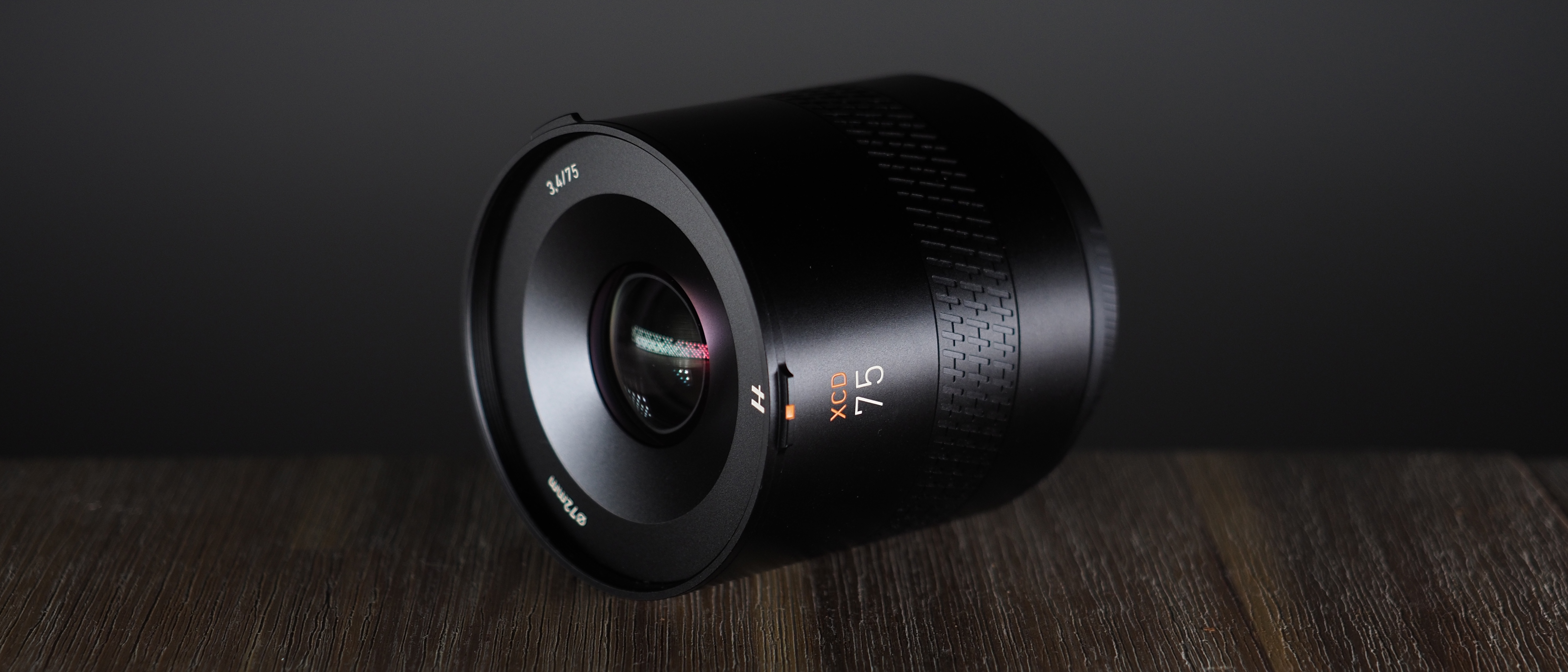Digital Camera World Verdict
The Hasselblad XCD 75P is a wonderful addition to the X System lineup. Its effective 59mm focal length makes this a great general purpose lens, and with stellar sharpness across the frame this is one of the niftiest 50-somethings you'll ever use. Despite being a Portable lens, it's not nearly as small as the XCD 28P or 45P – but it does boast a faster f/3.4 aperture. Plus, it's way smaller and lighter than the old XCD 65mm. If you temper your expectations about its size, the 75P is a dynamite performer – and still compact enough to make it an essential everyday carry companion.
Pros
- +
Super sharp
- +
Light and compact
Cons
- -
Not as small as the 28P & 45P
- -
No focus clutch / scale
Why you can trust Digital Camera World
It's been interesting seeing Hasselblad update its XCD range over the past few years – and the Hasselblad XCD 75P is one that I've personally been waiting for.
After dropping a few V-series lenses and debuting its first E-series optic (the wonderful Hasselblad XCD 20-35E), I was wondering if we'd see another P-series lens. On top of that, we haven't had a new standard lens in over half a decade.
So I was very pleased to get my hands on the Hasselblad XCD 75P, with its f/3.4 aperture and 59mm full frame equivalent focal length – though I was a little surprised by the size of this P(ortable) lens.
Still, with its glass-cuttingly sharp performance and sling bag-friendly frame, this is one of my favorite lenses for the X System.





Hasselblad XCD 75P: Specifications
| Mount options | Hasselblad X |
| 35mm focal length | 59mm |
| Image stabilization | No |
| Weather sealing | No |
| Focus | Auto, manual |
| Control ring | Yes |
| Lens construction | 10 elements in 10 groups |
| Minimum aperture | f/32 |
| Filter size | 72mm |
| Dimensions (len x dia) | 71 x 75mm |
| Weight | 398g |
Hasselblad XCD 75P: Design & Handling
As noted, this is the latest Hasselblad P lens – which stands for Portable. The other two members of the family are the XCD 28P, which at 43.5mm long and 245g in weight was the smallest and lightest medium format lens when it debuted, along with the older XCD 45P from 2018, which comes in at 47mm and 320g.
You might be forgiven for expecting the Hasselblad XCD 75P to be a similarly diminuitive lens, but in fact it's quite a bit bigger – measuring 71mm and weighing in at 398g.
For context, that actually makes it bigger than some of the V (Versatile) lenses – including the XCD 55V, which as you can see in the image below is a little bit smaller (and, at 372g, also lighter).
This definitely feels a little bit odd, for a Portable series lens. But while it's bigger than its siblings, it's still considerably smaller than the lens it effectively replaces: 2018's XCD 65mm, which is a very chonky boi at 93mm in length and tipping the scales at 727g.

Other people might be more hung up on the size, but I'm not really that fussed about it – particularly since the XCD 75P is a whole lot smaller than both the XCD 90V and XCD 25V. All that really matters to me is that this is a very lightweight and compact prime, which works great as my "default lens" to leave on the front of my X2D to use as a daily driver.
The Portable distinction does, however, mean that the 75P lacks a few additional controls found on V lenses. This includes the manual focus clutch and focus scale, and the second customizable control ring (along with the 90V's slide switch to click or declick it).
As someone who doesn't zone focus, the clutch isn't something I particularly miss – especially when it makes space for the wider focus ring found on the 25V and 90V, which is better for manual focusing (as you can see in the image above, it's three "Hasselblad Hs" wide instead of two).
Likewise, I never use the control ring on any of my lenses (Hasselblad or otherwise) so its absence won't cause me any sleepless nights. If either or both of these is part of how you shoot then I understand that it might be more bothersome – but this is nonetheless standard for P lenses.
Hasselblad XCD 75P: Photo Performance

The Hasselblad XCD 75P just plain delivers. It's been a while since I took a standard lens for a spin on an X camera, so the 59mm equivalent focal length was like meeting an old friend when I put it on my X2D.
As someone whose first love is shooting portraiture, this is a lens that I've been really looking forward to. A standard prime is ideal for half-length portraiture and environmental portraits, so this is the perfect tag team partner with the XCD 90V (with its effective 71mm field of view) for tight headshots.
As with all the new XCD lenses, autofocus here is both swift and silent. That's thanks to the phase detect AF of the X2D body as realized by the linear stepping motor, which makes both fine and broad focus adjustments quickly and accurately.
If you want to go manual, as noted in the handling section above, the focus ring is the wider "triple H" affair found on larger V lenses – including the 90V, which again makes them such a harmonious pairing as you switch between the two and still retain the same tactile control.
Manual focusing used to be essential for portraiture on the old Hasselblad X1D, as its contrast-based AF system often struggled to keep up, and as an old film shooter I always enjoy using the focus ring on these lenses – though obviously, as a Portable lens that lacks the focus clutch / scale, it's fully fly-by-wire here.

While the 75P is the fastest of the Portables, with its f/3.4 aperture (compared to the f/4 of its stablemates), it's obviously slower than the f/2.5 of the Versatile primes. But that didn't affect my shooting experience at all, particularly as the X2D is so clean even when you push the ISO.
And even as a bit of a bokeh slut, I was very pleased with the defocus of the 75P – especially the smeary, buttery transitions in background elements. In fact, I was very fond of how it rendered out-of-focus foreground elements as well – which isn't something I tend to play with much, so I had a lot of fun experimenting with it here.
To my shame, I forgot to enable the in-body image stabilization on my X2D – or, rather, forgot to re-enable it after my colleague Ben turned it off to conduct our lab tests. As a result, some of my sample shots were a little on the shaky side until I figured out what was going on!
To that point, while we have performed our lab tests, lab manager Ben is currently away and hadn't provided our usual graphs to illustrate the 75P's performance. However, from the lab data I can tell you that this is a pretty outstanding lens.
Its center sharpness is scarily good, and at f/8 and f/11 actually outresolves the mighty XCD 90V – which is the sharpest lens we've ever tested. Middle and edge sharpness is also exceptional; using our spatial frequency response tests, a score approaching 2,000 is considered very good, and the 75P only drops below that at f/22 (peaking at a brilliant 3595 in the center when shooting at f/4).
Hasselblad XCD 75P: Sample Images




Hasselblad XCD 75P: Lab results
We run a range of lab tests under controlled conditions, using the Imatest Master testing suite. Photos of test charts are taken across the range of apertures and zooms (where available), then analyzed for sharpness, distortion and chromatic aberrations.
We use Imatest SFR (spatial frequency response) charts and analysis software to plot lens resolution at the center of the image frame, corners and mid-point distances, across the range of aperture settings and, with zoom lenses, at four different focal lengths. The tests also measure distortion and color fringing (chromatic aberration).
Sharpness:

As we've come to expect from XCD lenses, sharpness is incredible throughout the majority of the aperture range. Even wide open at f/3.4 the lens resolves a sensational amount of fine detail.
Fringing:

Color fringing is very minimal throughout the entire aperture range and isn't easily visible in real-world shooting.
Distortion: 1.66
The XCD 75P produces moderate pincushion distortion, but it's easily corrected.
Hasselblad XCD 75P: Verdict
The Hasselblad XCD 75P is a fantastic standard prime that's sharp enough for the most challenging professional work, and small enough to be an everyday carry for travel and walkabout shooting.
While it's certainly on the larger side, in the context of the Portable line in which it sits, it's still a very discreet lens and makes a wonderful pairing with either the X2D or the 907X & CFV 100C.
I loved using the XCD 75P for portraiture, reportage and street photography – and if you're a portrait or fashion photographer, this completes the trifecta for headshot, half-length and full-length shooting with the XCD 38V and XCD 90V.
The "nifty fifty" is widely considered an essential lens for every camera system, and I dare say that this "nifty fifty-nine" is perhaps the obvious choice for anyone looking to climb aboard Hasselblad's mirrorless system with a lens that can shoot pretty much anything.
Alternatives

Hasselblad XCD 65mm
Launched in 2018, this is one of the last-generation XCD lenses – bearing the tulip shape favored by some of that line. It has a faster f/2.8 aperture and a narrower 50mm equivalent field of view, but is considerably bigger and heavier.

Hasselblad XCD 55V
It's slightly wider than standard, at an equivalent 43mm, but fits the bill if you're in the market for something in the ballpark. It comes in slightly smaller and lighter than the 75P, with a faster f/2.8 aperture, and has a focus clutch.
Take a look at the best Hasselblad cameras, which are among the best medium format cameras available.

James has 22 years experience as a journalist, serving as editor of Digital Camera World for 6 of them. He started working in the photography industry in 2014, product testing and shooting ad campaigns for Olympus, as well as clients like Aston Martin Racing, Elinchrom and L'Oréal. An Olympus / OM System, Canon and Hasselblad shooter, he has a wealth of knowledge on cameras of all makes – and he loves instant cameras, too.


